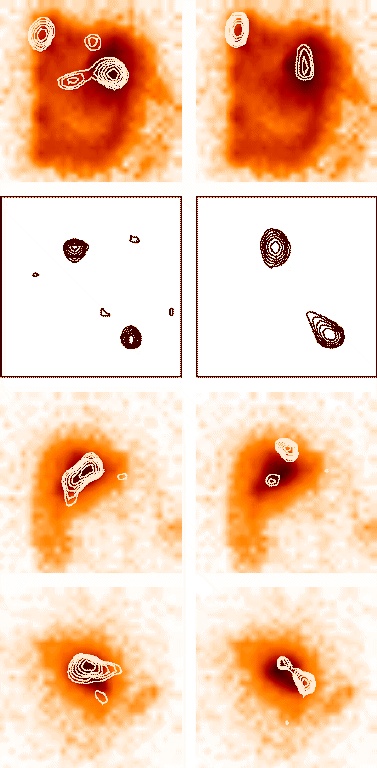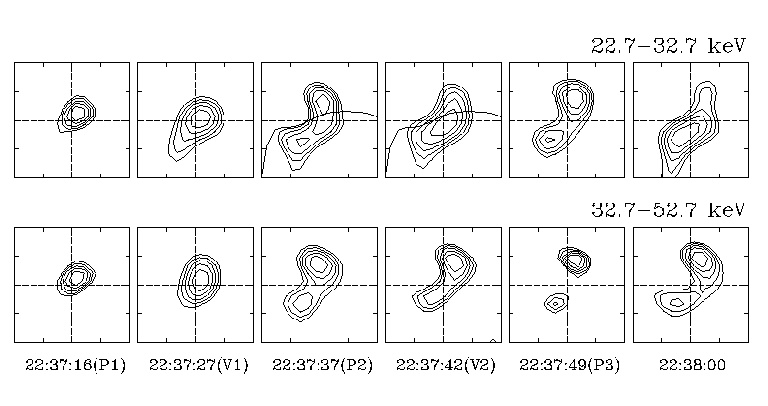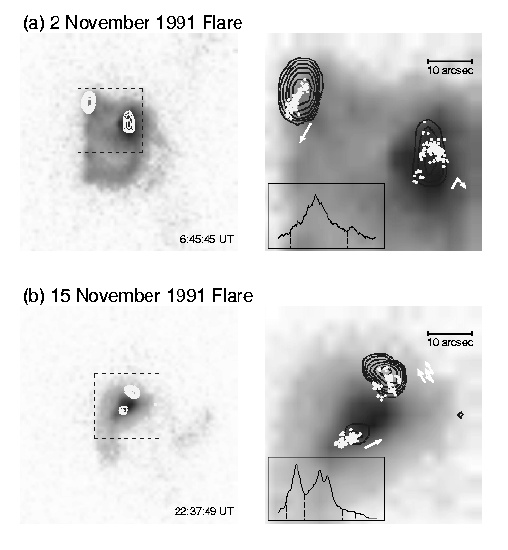



Hard X-ray imaging observations of intense impulsive flares with the Yohkoh/HXT have revealed that the hard X-ray emission in the energy range above 30 keV originates most frequently from double sources, suggesting that the bulk of hard X-rays is emitted from footpoints of flaring magnetic loops.


An X-class flare occurred on 15 November 1991. The time profile of this flare has outstanding three spikes. We analyzed the change of a hard X-ray structure during the impulsive phase, including these three spikes. This figure shows hard X-ray images at the peaks and valleys of these spikes (37" x 37" FOV). Each tick interval corresponds to 10". The pointing jitter of the spacecraft was corrected. Images in the 22.7-32.7 keV energy range are shown in the upper row, while those in the 32.7-52.7 keV range are in the lower row. Magnetic neutral lines are shown in P2 and V2 images in the 22.7-32.7 keV range. The contour levels are the same as in figure 2. The data averaging times are 1, 1.5, 0.5, 0.5, 0.5, and 1 s for 22.7-32.7 keV images, and 1.5, 3, 0.5, 1.5, 1, and 2 s for 32.7-52.7 keV images, respectively. From these figures, double footpoints sources are clearly observed at the peak of spikes and in the higher energy range. At the valley, a source located between two footpoints becomes dominant, especially in the lower energy band. In addition to this analysis, we compared time profiles of double footpoint sources in detail. It was found that the time-lag between intensity variations of these two sources, was shorter than 0.1 sec. Considering the size of magnetic loop connecting these two footpoints, only electrons which are accelerated around the top of the loop, can emit hard X-rays with such a short time difference at the both ends of the loop.

(a) 2 November 1991 flare.
Left:
Hard X-ray double sources in the M2-band (white contours)
at the peak of hard X-ray emission in the M2-band (at 6:45:45 UT) overlaid on
a soft X-ray image taken with the Be filter of SXT at the corresponding time
(negative grayscale).
The box with dashed lines indicates the image area for the right panel.
Right:
Centroid positions of the double sources (white dots) in every 0.5 s
from 6:45:20 UT to 6:46:19 UT, overlaid with the same hard and
soft X-ray images in the left panel
(black contours and negative grayscale, respectively).
The M2-band time profile is shown in the inset, with the above-mentioned
time interval indicated by dashed lines.
(b) 15 November 1991 flare.
Left:
Hard and soft X-ray images (in the M2-band and with the Be filter,
respectively), at the peak time of M2-band hard X-ray emission
(22:37:49 UT).
Right:
Centroid positions of the double sources
from 22:37:32 UT to 22:38:08 UT (white dots).
Trajectory of the northern footpoint consists of two
clearly-separated ``lines'', and possibly an additional one to the north-west
of the two lines.
The footpoint moves from lower-right to upper-left
direction in each of the line, starting from the one nearest to the southern
footpoint.
The M2-band time profile is shown in the inset, with the above time interval
shown in dashed lines.
Dotted lines in the same inset indicate the timing where
the location of the northern footpoint jumps from the upper-left edge to
the lower-right edge of the next line in the trajectory.
Note the jump from the first to the second line
just corresponds to a valley seen in the hard X-ray time profile.
For both of the flares,
the effect of spacecraft jitter is removed, with typical accuracy for the
determination of centroid positions ~ +/- (0.3"-0.5")
(at the 1-sigma level).
Contour levels of hard X-ray sources in each of the four panels
are 70.7, 50.0, 35.4, and 25.0 % of the peak brightness.
Solar north is to the top, east is to the left.